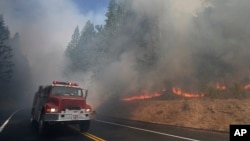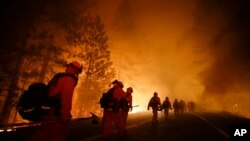SAN FRANCISCO —
One of the largest California wildfires in decades roared largely unchecked for a 10th day through forests in and around Yosemite National Park on Monday and threatened a reservoir that supplies most of San Francisco's water.
As of midday, the eastern flank of the so-called Rim Fire had burned to within a mile of Yosemite's Hetch Hetchy reservoir on the Tuolumne River, raising concerns about the possibility of ash and soot contaminating the sprawling artificial lake.
On Saturday, flames had been no closer than four miles from the reservoir, which supplies 85 percent of the water consumed by 2.6 million people in San Francisco and several communities in three adjacent counties about 200 miles (320 km) to the west.
Roughly 300 million gallons of water is carried to the San Francisco Bay area daily through tunnels and an aqueduct, and reservoir samples show water quality has remained healthy since the fire began on Aug. 17, according to a spokeswoman for the San Francisco Public Utilities Commission.
“There's no evidence of a change in the water quality, and there's no change in our ability to deliver that water to all of our customers,” said the spokeswoman, Suzanne Gautier.
If fallout from the blaze were to foul the Hetch Hetchy, its water could be diverted to a smaller Bay Area reservoir for filtration at a local treatment plant before delivery to customers, she said.
The Rim Fire, named for a Stanislaus National Forest lookout point called Rim of the World, has already damaged two of the three hydropower generating stations linked to the Hetch Hetchy reservoir that supply electricity for all of San Francisco's public facilities, such as hospitals and firehouses.
Gautier said the city for now was continuing to draw on reserve power stored for emergencies and purchasing additional electricity on the open market to make up for the difference.
Despite threats to water and power, firefighters have made headway against the blaze, although rugged terrain and the fire's remote location were complicating efforts to subdue the flames, fire managers said.
“There are places where they can't get in,” said Mike Ferris, a spokesman for the National Interagency Fire Center in Boise, Idaho. “It's just inaccessible.”
As of Monday morning, fire crews working with hand tools and backed by bulldozers and water-dropping helicopters had carved containment lines around 15 percent of the blaze's perimeter, more than double Sunday's figure, though the fire's footprint continued to grow.
Over 200 Square Miles Scorched
The blaze in the western Sierra Nevada Mountains was among the fastest-moving of some 50 large wildfires raging across the drought-parched U.S. West. The fires have strained resources and prompted fire managers to open talks with Pentagon commanders and Canadian officials about possible reinforcements.
According to the latest estimates, the Rim Fire has charred nearly 150,000 acres (60,703 hectares) or 234 square miles - the size of the city of Chicago - most of that in the Stanislaus National Forest west of Yosemite.
That ranks the blaze as the largest wildfire in California since August 2009, when the so-called Station Fire ravaged nearly 145,000 acres of the Angeles National Park north of Los Angeles, and one of the 20 biggest in state history, according to the California Department of Forestry and Fire Protection.
By Monday morning, nearly 22,000 acres (8,903 hectares) within Yosemite had burned, forcing the closure of the main road leading into the park from the San Francisco Bay area and prompting the evacuation of 74 campsites in the park's White Wolf area, officials said.
But the majority of the 1,200-square-mile Yosemite National Park, including the Yosemite Valley area famous for its towering rock formations, waterfalls, meadows and pine forests, remained open to the public.
The fire was not believed to pose a threat to the concrete structure of the 90-year-old O'Shaughnessy Dam, which forms the Hetch Hetchy Reservoir, or of the granite basin it was built into, Gautier said.
But in addition to the immediate potential fallout of ash and soot, Hetch Hetchy's water could be left vulnerable to heavy runoff of debris and topsoil stripped of vegetation by the blaze and washed into the reservoir by winter rains, she said.
“When you burn down everything, you've got a moonscape out there when floods can contaminate the water,” Governor Jerry Brown said during a visit to the fire zone on Monday. He declared a state of emergency for San Francisco on Friday due to threats to the city's water supply.
The blaze has destroyed about a dozen homes and 1,000 outbuildings, and some 4,500 additional dwellings remained threatened. Residents in the tiny town of Tuolumne and other communities near the western edge of the park were evacuated, but evacuation orders have been lifted for the enclaves of Pine Mountain Lake and Buck Meadows.
The cause of the wildfire remained under investigation. More than 3,700 firefighters have been assigned to the blaze, which was burning over steep terrain through scrub, oak and pine, stoked by stiff winds, high temperatures and low humidity.
As of midday, the eastern flank of the so-called Rim Fire had burned to within a mile of Yosemite's Hetch Hetchy reservoir on the Tuolumne River, raising concerns about the possibility of ash and soot contaminating the sprawling artificial lake.
On Saturday, flames had been no closer than four miles from the reservoir, which supplies 85 percent of the water consumed by 2.6 million people in San Francisco and several communities in three adjacent counties about 200 miles (320 km) to the west.
Roughly 300 million gallons of water is carried to the San Francisco Bay area daily through tunnels and an aqueduct, and reservoir samples show water quality has remained healthy since the fire began on Aug. 17, according to a spokeswoman for the San Francisco Public Utilities Commission.
“There's no evidence of a change in the water quality, and there's no change in our ability to deliver that water to all of our customers,” said the spokeswoman, Suzanne Gautier.
If fallout from the blaze were to foul the Hetch Hetchy, its water could be diverted to a smaller Bay Area reservoir for filtration at a local treatment plant before delivery to customers, she said.
The Rim Fire, named for a Stanislaus National Forest lookout point called Rim of the World, has already damaged two of the three hydropower generating stations linked to the Hetch Hetchy reservoir that supply electricity for all of San Francisco's public facilities, such as hospitals and firehouses.
Gautier said the city for now was continuing to draw on reserve power stored for emergencies and purchasing additional electricity on the open market to make up for the difference.
Despite threats to water and power, firefighters have made headway against the blaze, although rugged terrain and the fire's remote location were complicating efforts to subdue the flames, fire managers said.
“There are places where they can't get in,” said Mike Ferris, a spokesman for the National Interagency Fire Center in Boise, Idaho. “It's just inaccessible.”
As of Monday morning, fire crews working with hand tools and backed by bulldozers and water-dropping helicopters had carved containment lines around 15 percent of the blaze's perimeter, more than double Sunday's figure, though the fire's footprint continued to grow.
Over 200 Square Miles Scorched
The blaze in the western Sierra Nevada Mountains was among the fastest-moving of some 50 large wildfires raging across the drought-parched U.S. West. The fires have strained resources and prompted fire managers to open talks with Pentagon commanders and Canadian officials about possible reinforcements.
According to the latest estimates, the Rim Fire has charred nearly 150,000 acres (60,703 hectares) or 234 square miles - the size of the city of Chicago - most of that in the Stanislaus National Forest west of Yosemite.
That ranks the blaze as the largest wildfire in California since August 2009, when the so-called Station Fire ravaged nearly 145,000 acres of the Angeles National Park north of Los Angeles, and one of the 20 biggest in state history, according to the California Department of Forestry and Fire Protection.
By Monday morning, nearly 22,000 acres (8,903 hectares) within Yosemite had burned, forcing the closure of the main road leading into the park from the San Francisco Bay area and prompting the evacuation of 74 campsites in the park's White Wolf area, officials said.
But the majority of the 1,200-square-mile Yosemite National Park, including the Yosemite Valley area famous for its towering rock formations, waterfalls, meadows and pine forests, remained open to the public.
The fire was not believed to pose a threat to the concrete structure of the 90-year-old O'Shaughnessy Dam, which forms the Hetch Hetchy Reservoir, or of the granite basin it was built into, Gautier said.
But in addition to the immediate potential fallout of ash and soot, Hetch Hetchy's water could be left vulnerable to heavy runoff of debris and topsoil stripped of vegetation by the blaze and washed into the reservoir by winter rains, she said.
“When you burn down everything, you've got a moonscape out there when floods can contaminate the water,” Governor Jerry Brown said during a visit to the fire zone on Monday. He declared a state of emergency for San Francisco on Friday due to threats to the city's water supply.
The blaze has destroyed about a dozen homes and 1,000 outbuildings, and some 4,500 additional dwellings remained threatened. Residents in the tiny town of Tuolumne and other communities near the western edge of the park were evacuated, but evacuation orders have been lifted for the enclaves of Pine Mountain Lake and Buck Meadows.
The cause of the wildfire remained under investigation. More than 3,700 firefighters have been assigned to the blaze, which was burning over steep terrain through scrub, oak and pine, stoked by stiff winds, high temperatures and low humidity.











